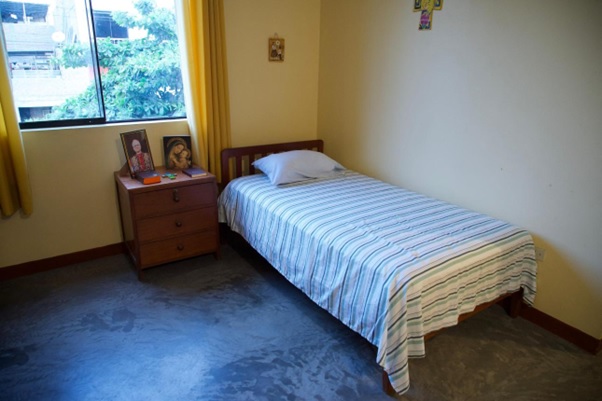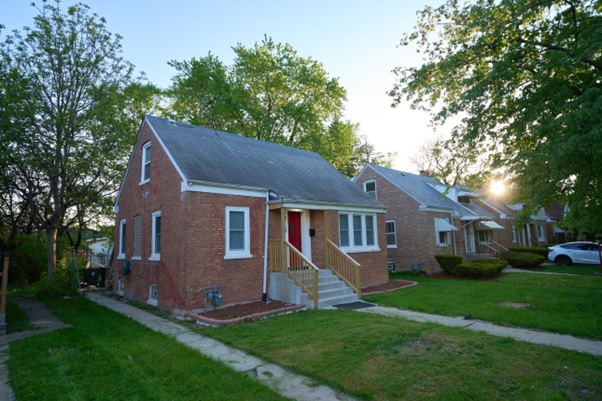
Pope Leo XIV as a child, as a young seminarian and meeting Pope John Paul II
The Real Pope Leo XIV — by Those Who Knew Him in Rome, Chicago and Peru
By Tom Kington , Rome
Will Pavia , Chicago
and Iñigo Alexander, Bogota
The young man who went to Villanova University in Pennsylvania to study mathematics and returned to Chicago to train as a priest struck Art Purcaro as personable and very capable. “I would never have discussed the word ‘ambition’ with Bob at all,” he said.
He was devoted to his calling. “He left his home, the family he had in the United States to work with the people of Peru and become one with them, a citizen — to do for them, not to do with them.”
Purcaro, who hails from the Bronx, New York, and in 1975 went to work as an Augustinian missionary in Peru, recalled meeting there in the early 1980s Robert Prevost, the man who this week became Pope Leo XIV . Now the assistant vice-president at Villanova, Purcaro travelled to Rome at the end of last month to celebrate the 50th anniversary of his ordination. While there he met his old friend before he and the other cardinals went into conclave.

Pope Leo conducts Mass in the Sistine Chapel in the Vatican where the conclave was held that elected him to the papacy - Vatican Media/AFP/Getty Images
The possibility that he might be chosen was weighing on him, Purcaro said. “Simply because his name had been in the press as a possible candidate, amid the seven or ten others. He would never be chosen because he was American — that was the typical caveat. But he’s a more international person than you are ever going to find. He spent a greater part of his life in Peru.”
Nevertheless, his friend did bear at least a few of the marks of a man from Chicago . “He loves deep-dish pizza,” Purcaro said.
Although the new Pope’s formative years were spent in the US, it was Peru, and the city of Chiclayo in particular, that forged his faith. Leo, who was often heard saying he had “come from Chicago to Chiclayo — the only difference is a few letters”, would serve for two decades in Peru, where he became a bishop and a naturalized citizen.
“The Latin Americans at the conclave saw him as the second South American pope in a row,” said Austen Ivereigh, an expert on Catholicism in Latin America and a biographer of Francis, who was Argentinian. “That is the genius of this election: both the US and South America can claim him.”
His election was received with joy and pride by many emotional Peruvians who remember him not as a distant cleric but as a pastor who walked among them. “The whole country should be happy because he is more Peruvian than American,” said Sister Margarita Flores, who knew him.
In the northern city of Chiclayo, Leo became known for his modesty and quiet strength. He prioritized visits to remote rural communities and launched programs against child malnutrition. His leadership style was gentle but firm, rooted in compassion and listening.
“Those of us who have already seen him work in Chiclayo know of his close pastoral experience with the people,” Father Rafael Fernández, a theologist and university rector, told the Peruvian newspaper El Comercio.
Locals remember not only his spiritual guidance but his warmth. Flores recalled that during his tenure in Chiclayo, he opened a soup kitchen and launched projects for the poor.

The room at the Augustine Convent Santo Tomas de Villanueva in Trujillo, northern Peru, where Pope Leo lived as Father Robert Prevost during his ministry there from 1988-99 - Steffano Palomino/AFP/Getty Images
“He may not have an effusive charisma, but with his simplicity he was able to reach many people,” she said. However, he was not afraid of making enemies.
Paola Ugaz, an investigative journalist who has been battling corrupt priests for years, had nothing but praise for him. “I would say he’s empathetic, helpful and does the right thing, and I’m not even Catholic,” said Ugaz, as she recounted how Prevost backed her investigation into the religious order Sodalitium Christianae Vitae (SCV).
After Ugaz helped lift the lid on alleged cultlike sexual abuse at the order, Leo, a cardinal at the time, ousted a bishop with ties to the order and the Vatican shut it down. The incident resurfaced this week amid claims that when Prevost was a bishop in Chiclayo in 2022, he covered up for two priests accused of molesting women by sabotaging an investigation. Ugaz said this was untrue and a smear campaign.

The humble former home of the Prevost family in Dolton, Illinois - Matthew Gilson for The Times
“When Provost went after SCV, a revenge campaign against him started. The truth is that when Prevost heard the allegations by the women, he urged them to go to the police and referred the case to Rome. Maybe he didn’t do enough, but there was never any cover-up,” she said.
The bust-ups are likely to be only just getting started given that as a cardinal, he criticized the Trump administration over its migrant crackdown. Laura Loomer, a right-wing podcaster and occasional Trump adviser, celebrated Leo’s election by calling him “anti-Trump, anti-Maga, pro-open borders and a total Marxist, like Pope Francis”, saying it was “gross” that he is now in charge of the Vatican.
However, the new Pope seems to be a Republican, like Loomer, after voting for the party in at least three primaries in his native Illinois, according to electoral records.
While his predecessor famously said, “Who am I to judge?” when asked about homosexuality, Leo told bishops in 2012 the “homosexual lifestyle” was “at odds with the Gospel”. Something the 69-year-old does has in common with Francis is that they both hailed from religious orders — Leo from the Augustinians and Francis the Jesuits.
“That shows you where the energy is in the Catholic Church today,” said Massimo Faggioli at the Augustinian Villanova. The orders have sharp differences, he added. “St Augustine was writing at the time of the collapse of the Roman Empire and the order is less optimistic than the Jesuits — they are different animals,” he said.
The Pope’s ties to the US are deep, growing up in a small brick house in a working-class suburb south of Chicago, the third son of Millie and Louis Prevost. “Millie and Louis were proud members of St Mary’s,” said Scott Kuzminski, 63, who grew up in the neighborhood and attended the Catholic grammar school attached to the church, St Mary’s of the Assumption. “It was a hardscrabble school,” he said. “It was predominantly Irish at the time.”
His father was a school superintendent and his mother established a library at St Mary’s. They were the kind of people who volunteered for jobs in the church, Kuzminski said. Leo’s mother was a brilliant singer, in church and in theatre productions.
“I was in Fiddler on the Roof, she played Golde. I was in the choir as a villager. The irony of singing the [Jewish] Sabbath prayer with the Pope’s mother,” he said, trailing off. “I don’t know how that happened.”
Some now claim to have foreseen his rise in the church. When his older brothers were playing cops and robbers, their younger sibling would play the part of a priest and hand out biscuits as if they were communion wafers, his brother Louis, who now lives in Florida, told the television station WWSB. “We used to tease him all the time, ‘You’re going to be the pope one day’,” he said. “Neighbors said the same thing. Sixty-some years later, here we are.”
In his early teens, Leo went to St Augustine Seminary High School in Michigan, a boarding school housed inside a mansion that was built by a late 19th century industrialist. The school is said to have observed Augustinian traditions of communal living. It has since closed but Leo returned there in 2013 to attend a school reunion. The Pope’s older brother John has said he is a fan of the Chicago White Sox, an allegiance that would suggest the new Pope also knows the meaning of suffering.
Back home in Chicago, the neighborhood where he grew up has changed dramatically since the 1980s, as local factories closed and many people moved away. The school he attended closed in 2000; St Mary’s held its last Mass in 2013, according to Kuzminski, the former neighbor. Some of the houses on the street are now vacant, with boards in their windows or smashed glass. A few cats prowl along the lawns in the morning sunshine. Donna Sagna, 50, a singer who lives next door to the Pope’s former home, said she moved in eight years ago. The Pope’s former house was now “a house that people sold drugs out of”, she said.
It is a far cry from the finery of Vatican City among which Leo now finds himself, although by all accounts it is a change that will not faze him.
“He is remarkably calm. He seemed to take it in his stride. At lunchtime today he turned up in Santa Marta, sat down at a table — a special chair, mind you — and waited until someone brought him his lunch. And there was no fuss, no fuss at all,” said the English cardinal Vincent Nichols, who worked with Leo over a number of years. “He’s got a gentle manner. He’s very calm. He’s quite clear in his mind. He can be decisive. I’ve seen him resolve difficulties in a way that didn’t leave enemies behind him.
“And he can hold people together. In terms of governance, he has a doctorate in canon law, so he knows how things should be done.”
A few days before his old friend Bob became the Pope, Purcaro joined him for dinner. “A very decent meal,” he said of the salmon and greens Leo cooked for him.
“He was busy, he was getting ready for conclave,” he said. “But he walked me down to the basilica so I could pray the following morning.”
He put on his vestments to bring Purcaro through security, “so I could get a good seat — this is the kind of person he is”.
He is still getting used to the idea that his friend is Leo XIV.
“I like the idea, the fact that when someone becomes pope, they change their name,” he said. “He’s had a new birth. He’s called to be more than he was.” But he also feels, “Bob will always be Bob”. - The Times

